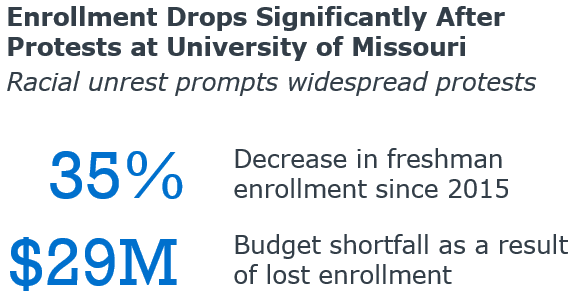4 pitfalls that create enrollment risk during a crisis—and what to do about them
Campus climate crises are occurring across all types of colleges and universities. Although crises span a wide range of issues, the most common ones today are related to free speech, sexual misconduct, bias-related speech or action, and racism. These incidents can be unpredictable and cause heightened levels of activism, media and public scrutiny, and reputational damage. Climate crises can originate from many different actors, including institutions themselves, third-party organizations, faculty, staff, and students.
Poorly managed campus climate incidents jeopardize reputation and enrollment
A campus climate incident has potentially damaging consequences for an enrollment manager’s goals and priorities. For example, prospective students and their families may perceive the campus environment to be unwelcoming or unsafe and may distrust the institution’s approach to addressing the incident. This can cause downstream enrollment effects, such as reducing application volume and yield and causing damage to your reputation in the long term, making it more difficult to recruit new students.
Enrollment fallout at the University of Missouri following widespread student protests in 2015 is the most prominent example of the damaging repercussions a climate crisis can have. Over three years, Mizzou saw a 35 percent decrease in freshman enrollment, resulting in a budget shortfall of nearly $29 million.

Source: The Editorial Board, “More Misery in Missouri,” The Wall Street Journal, June 15, 2018.
Media attention can exacerbate the reputational damage caused by climate crises. A Harvard Business School study found that when an institution’s crisis is featured five or more times in The New York Times, applications drop by nearly 9 percent the following year, equivalent to a 10-ranking drop in the US News and World Report rankings.
When working to mitigate the enrollment and reputational impact of campus climate crises, enrollment managers experience four core challenges:
Challenge 1: Climate issues make it harder to recruit and retain underrepresented students
Climate incidents can disproportionally affect underrepresented minorities, often the population enrollment managers are working the hardest to recruit and retain. As the population of underrepresented minorities at an institution decreases, these students are more likely to feel less welcome on campus and experience higher rates of discrimination. More and more, families are prioritizing “fit” over other factors when selecting a university, resulting in an enrollment boom at HBCUs.

Source: Sylvia Hurtado and Adriana Ruiz Alvarado, “Discrimination and Bias, Underrepresentation, and Sense of Belonging on Campus,” HERI, October 2015.
Challenge 2: Students demand rapid responses
Today’s Millennial and Generation Z students expect the organizations they support to demonstrate values consistent with their own. They demand decisive, progressive action on issues they care deeply about. Students are quick to organize on campus and protest university actions if these actions do not align with students’ values. When parents of prospective students see unrest on campus, they feel concerned that their child may not be safe attending the school.

Source: “Millennials, Politics and Causes: The 2016 Millennial Impact Report,” The Millennial Impact; Jake New, “Get Ready for More Protests,” Inside Higher Ed, February 11, 2016.
Challenge 3: Social media creates and spreads a narrative you can’t control
Students are quick to dissect events and institutional messaging on social media. Prospective students and their families can be influenced by these narratives and develop a sense of who you are as an institution without ever directly engaging or communicating with you.
Challenge 4: The enrollment perspective is absent from crisis response planning
When a climate incident hits, senior leaders can be overly focused on reducing the incident’s impact on current students and alumni, and not be aware of the effect climate incidents have on prospective students and families. Furthermore, senior leaders can overlook enrollment managers when planning the institution’s response. To ensure the enrollment impact stays top of mind, enrollment managers should educate senior leadership about enrollment risks and advocate for including the enrollment perspective to guide the crisis response.
Educate senior leadership about effective crisis response to mitigate enrollment impact
To assist enrollment managers with this advocacy effort, EAB has created an executive briefing to educate senior leadership about the climate issues energizing students and the potential enrollment and reputational impact. The briefing outlines EAB’s five recommendations to improve institutional preparation and response to campus flashpoints before they ignite into crises. We recommend reviewing this briefing as a senior leadership team to identify strengths and prioritize areas of improvement.
More Blogs

Is your yield rate okay?

Demographics shape the enrollment landscape, but strategy determines success
